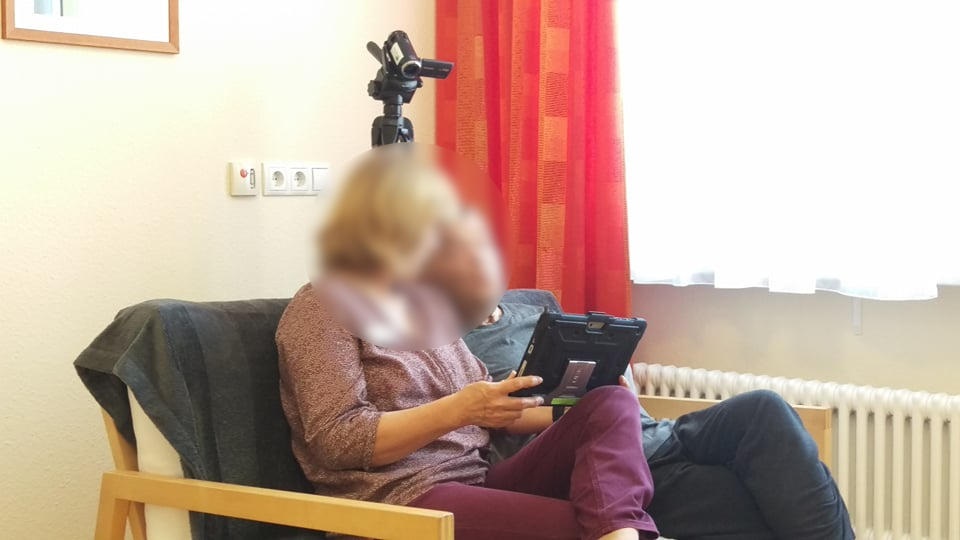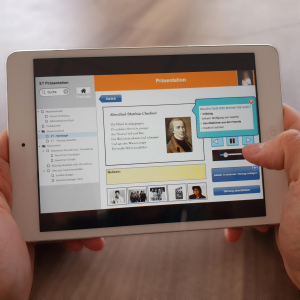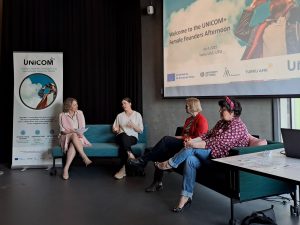Yhä useampi nuori Suomessa kokee yksinäisyyttä, ulkopuolisuutta ja eristäytyneisyyttä. Tähän ongelmaan pyritään puuttumaan NOPPA-hankkeella, jossa osallisuutta lisätään pelillistämisen avulla. …
Tekijät | Authors

Master School International Seminar 1: Rekindling Autobiographical Memories of People with Dementia via Digital Technology – the RemeMTI Project
The European society is ageing (Eurostat 2019). What may now seem as a distant problem may become a major societal as well as healthcare challenge in the coming decades. As the “demographic change” – in combination with an ever-increasing expectancy of life – progresses, the population stratum of people aged 65 or more years will significantly increase in many EU states.
Age and Dementia
With increasing age also comes increasing morbidity. Although modern medicine has managed to alleviate or even wipe out a great deal of diseases, some of them are still not curable as of today. One of these illnesses (or rather a class of illnesses, as the term dementia describes a syndrome which can have different causes) which also happens to be age-correlated, is dementia. In the following, we strictly refer to the most common cause of dementia, Alzheimer’s disease, for which there exists no known effective medication to date.
The degenerative brain changes that come with dementia pose a great challenge for society and healthcare, as they eventually impair the ability of the afflicted to cope with tasks of daily living. People affected by dementia gradually lose memory, problem-solving and communication skills (Alzheimer’s Association). At a certain point, the persons with dementia (PwD) will not be able to live independent anymore and inevitably become nursing cases.
Hence, formal and informal carers alike will become more and more emotionally burdened with time, as they have to witness the cognitive as well as the affective decline of the persons they care for. In particular cases, the declining mental health combined with certain care situations may also lead to “challenging situations” or “disruptive behaviors”, which in turn worsen the emotional connection between caregiver and PwD (Cheng 2017).
Reminiscence Therapy (RT)
In order to cope with the negative effects of dementia, it is helpful to assume a more positive “person-centered” approach of caregiving (Kitwood 1997). Person-centered care encourages an active as well as respectful interaction – even a “partnership” – between the person with dementia and the caregiver.
Thus, the focus should always lie on strengthening the residual abilities of the persons with dementia, fostering positive emotions and encouraging activity in order to preserve their identity. A viable way to keep the personhood – and with that the well-being – of PwD intact is to regularly conduct some form of Reminiscence Therapy (RT).
In RT, the basic idea is to have the caregiver trigger the long-lasting autobiographical memory of the PwD – either in a structured or an unstructured way. Strictly speaking, the triggered PwD then narrates about a personally important life event and then reflects the particular life event together with the caregiver (or the group, if it is a group RT session). In essence, this RT “life review” (Butler, 1963) is thought to maintain some kind of continuity and identity in the PwD’s life and at the same time reduce depression.
In the broadest sense, the autobiographical memory episode could also be channeled into any other personally meaningful interaction, such as sharing a laugh or creating an artifact together. Furthermore, the caregiver can use “helpers” such as photographs, music or objects to trigger reminiscence. Even if the desired level of reflection is not reached, the PwD and the caregiver still had a “joyful” reminiscence moment.

Technology-assisted RT
Going one step further, modern information and communication technologies (ICT) can be used to add value to the whole RT process. In the last two decades, various technologies have been created and evaluated almost exclusively in academic institutions.
One pioneering example was the Computer Interactive Reminiscence and Communication Aid (CIRCA), which provided audiovisual reminiscence content on touchscreen computers in order to create “a livelier and more engaging form of reminiscence activity than, for instance, a paper scrapbook” in the early 2000s (Astell et al., 2008). Its main aim was to “support reminiscence and conversation” via providing a collection of dementia-friendly multimedia triggers that was easily accessible over the touchscreen interface.
Nearly two decades later, the project InterMem – “Interactive Memories” – (Klein & Uhlig, 2016; www.intermem.org) expanded on the multimedia content idea by also providing multimodal stimulation and interaction. In that sense, demonstrators such as a large-scale gesture-controlled “display wall”, a tangible multimedia pyramid as well as a dementia-content social network were developed and evaluated in terms of the ability to elicit positive reminiscence moments in PwD. The research was accompanied by an extensive “contextual inquiry” (Beyer & Holtzblatt, 1998) hospitation phase, while the design was inspired by the REAFF (Astell, 2009) principles – responding, enabling, augmenting and failure-free – for developing technology for PwD. Throughout nearly all interactive RT interventions, positive effects such as higher verbal activity as well as positive emotions could be observed (Bejan, 2018).
While some shortcomings of “classic” RT may be alleviated by adding value via interactive systems in combination with multimedia content, the caregiver may still face additional challenges, such as:
- Difficulty finding suitable trigger content(s) because there is (/are) none available
- Difficulty finding suitable trigger content(s) because the biography of the PwD is unknown
- Lack of time to search for suitable trigger content(s)
- Lack of time to devise a structured RT session
To fill the “gap” between the feasibility of creating workable display and interaction devices – which can effectively create joyful moments in well-constructed “theoretical” environments – and implementing them into efficient practice – that gives the caregivers more time for high quality interactions with the PwD (and costs less time regarding the biography and content preparation) –, project RemeMTI was conceived.
Project RemeMTI – Design considerations, implementation and evaluation
In this line, RemeMTI strives to pave the way for a product combining the benefits of an easy to use reminiscence software for caregivers and PwD alike and at the same time being affordable for caregiving institutions or even informal carers.
As a blend of “remember” and the German term for human-technology interaction (“Mensch-Technik-Interaktion”), RemeMTI seeks to be a process-supporting tool for the whole RT process. It is by no means intended to replace the human-human interaction in RT, but rather a tool to facilitate said interaction by reducing the overhead needed to create and carry out RT sessions.
At its core, the RemeMTI app aims at making the creation, management, upkeep and execution of RT sessions less time consuming for the caregivers. On the other side, the PwD profit from contents and thus structured RT sessions specifically tailored to their interests.
In order to reach these goals, the main software components include
- PwD management providing the opportunity to enter individual demographic and biographic (life theme) data,
- content management that allows an easy to use upload, download, tagging of multimedia content to the app’s database as well as browsing for suitable content(s),
- RT session management for combining aforementioned content(s) in a meaningful sequence and to determine a suitable display layout,
- a display system that allows the multimedia playback of the RT sessions, and finally
- a feedback system in order to rate the played back session afterwards (summative component) and make notes during the session (formative component).
These components form the base of the RemeMTI app and thus the “minimum viable product” (MVP). Nevertheless, the app is built as a modular system and thus will allow for functional extensions in future iterations – if they turn out to add value to the process and the target groups.
With the RemeMTI tool,
- the caregiver easily learns of the intrinsic interests of the PwD in his care (even if these interests are previously unknown to him or her) and has access to premade content or sessions related to these interests,
- the PwD and the caregiver hence experience an effective and meaning- as well as joyful RT session based on content that triggers the PwD’s (autobiographical) interests,
- the feedback and the notes created in an antecedent RT session can create new insights for the following sessions and thus make them more pleasant and effective for all parties involved.
The preliminary research and development took place based on the findings from the project InterMem. It was conducted in accordance to the principles of human-centered design. The workflow was chosen according to the “Lean Product Development” method. Thus, the main aim to gain knowledge from a MVP to be deployed to and evaluated with select members of the target group. After each evaluation iteration, feedback was obtained from the respective users, which was in turn fed back into the next development iteration.
The prototype itself was then developed as a Microsoft Windows 10 UWP (Universal Windows Platform) app meant to run on a wide range of Windows (tablet) PCs (such as the Microsoft Surface) and consequently be distributed through the Microsoft Store. Content was acquired for a set of various “RT-specific life themes” (e.g. hobbies, historic daily activities, common jobs, animals) by manually searching on dedicated royalty-free media search engines (e.g. Creative Commons “CC search”). After the completion of the first MVP package, a tablet PC with the software was shipped to several regional dementia care institutions for testing.

Screen design of the early RemeMTI app prototype
Preliminary results and conclusions
The first trials were conducted in mid-2019. The introduction of the RemeMTI app was accompanied by a one-day training that also included a process proposal for implementing the concept of digital multimedia RT. The participating institutions were henceforth allowed to use the system at their own pace. As a tool for enhancing the already practiced “classic” RT, it could be used without additional effort on the part of the persons involved in the process. Furthermore, no additional “academic evaluation” pressure was put on the care personnel. Judging from the feedback, a great part of the caregivers and most of the PwD accepted the app and enjoyed triggering memories with and having positive memories triggered by individually structured reminiscence content. Additionally, having a content pool with suitable contents for PwD was perceived as particularly useful.

RemeMTI evaluation montage
On the “more formal” research side, a scientific human-technology interaction trial regarding the ideal “presentation type” for multimedia RT sessions was conducted in one of the participating institutions. The aim was to explore which form of multimedia content presentation type – unimodal pictures vs. simpler multimodal pictures with sounds vs. more complex multimodal movies – is most suitable for the use in multimedia RT sessions. On that basis, the search for and the development of new content will become more efficient and effective. The evaluation data is currently in analysis and the results are expected in the near future.
Going one step further, an interaction trial will be conducted in early 2020. The objective here is to find out which “interaction mode” with the content is best suited for multimedia RT sessions. In this regard, it will be especially interesting to derive the optimal interaction mode between the caregiver and the PwD in combination with the RemeMTI application.
As with every novel technology product – and especially in the sometimes complicated context of dementia –, shortcomings cannot be avoided (in most cases) but must instead be used to deduce lessons learned. With RemeMTI, the software was developed in a small team and thus some usability and program errors occurred, which may in turn have diminished the user experience. On the partner institution side, there was one dropout because of a tight care schedule, which did not allow the time needed to generate feedback.
Looking into the future, digital RT is the way to go, as it potentially reduces caregiver burden as well as increases the well-being of PwD. In order to further the research field as well as the user experience, the RemeMTI team implements the scientific findings as well as the users’ suggestions from the feedback sessions and creates ready-made sessions for an even less time consuming RT session planning. The long-term plan is to transfer the scientific insights into a start-up and to create a product that is usable by the public (that is involved with PwD). Hopefully, an efficient as well as effective product that suits the need of its users and adds value to their personal as well as their private life will be finished and available in the near future.
Acknowledgements
The RemeMTI team thanks all project partners – and especially the evaluation participants – as well as gratefully acknowledges the grants from the German Federal Ministry of Education and Research.
Literature
Alzheimer’s Association. https://www.alz.org/alzheimers-dementia/what-is-dementia
Astell, A. J. (2009, September). REAFF—a framework for developing technology to address the needs of people with dementia. In Proceedings of first international workshop RSW-2009, Cambridge, UK (Vol. 5, pp. 5-10).
Astell, A. J., Alm, N., Gowans, G., Ellis, M. P., Dye, R., & Campbell, J. (2008). CIRCA: A communication prosthesis for dementia. Technology and aging, 67-76.
Bejan, A., Gündogdu, R., Butz, K., Müller, N., Kunze, C., & König, P. (2018). Using multimedia information and communication technology (ICT) to provide added value to reminiscence therapy for people with dementia. Zeitschrift für Gerontologie und Geriatrie, 51(1), 9-15.
Beyer, H., & Holtzblatt, K. (1998). Contextual design: defining customer-centered systems (Vol. 1). Morgan kaufmann.
Butler, R. N. (1963). The life review: An interpretation of reminiscence in the aged. Psychiatry, 26(1), 65-76.
Cheng, S. T. (2017). Dementia caregiver burden: a research update and critical analysis. Current psychiatry reports, 19(9), 64.
Eurostat (2019). https://ec.europa.eu/eurostat/statistics-explained/index.php/Population_structure_and_ageing
Kitwood, T. M. (1997). Dementia reconsidered: The person comes first. Open university press.
Klein, P., & Uhlig, M. (2016, June). Interactive Memories: technology-aided reminiscence therapy for people with dementia. In Proceedings of the 9th ACM International Conference on PErvasive Technologies Related to Assistive Environments (p. 84). ACM.
Links to related contents
- Care & technology lab (IMTT) website https://imtt.hs-furtwangen.de/imtt/en/home-english/
- RemeMTI landing page https://imtt.hs-furtwangen.de/rememti/
- InterMem website http://www.intermem.org/
Pull-quotes:
- “[…] the focus should always be put on strengthening the residual abilities of the persons with dementia, fostering positive emotions and encouraging activity in order to preserve their identity […]”
- […] “Throughout nearly all interactive RT interventions, positive effects such as higher verbal activity as well as positive emotions could be observed […] “
- […] “the RemeMTI app aims at making the creation, management, upkeep and execution of RT sessions less time consuming for the caregivers. On the other side, the PwD profit from contents and thus structured RT sessions specifically tailored to their interests. […]”
- […] “a great part of the caregivers and most of the PwD accepted the app and enjoyed triggering memories with and having positive memories triggered by individually structured reminiscence content. […]”
- […] “Looking into the future, digital RT is the way to go, as it potentially reduces caregiver burden as well as increases the well-being of PwD. […]”








